Preamble-Based Adaptive Channel Estimation for IEEE 802.11p †
Abstract
1. Introduction
1.1. Related Work and its Limitations
1.2. Our Motivation and Contribution
- In our previous study [31], the proposed algorithm lacked a clear rationale. Therefore, in this study, we provide a theoretical analysis of the proposed algorithm. that can verify its validity.
- We show that the proposed scheme can selectively use the STA and MMSE or STA and TRFI channel estimation schemes. This proves that the proposed scheme can be expanded for any combinations of a channel estimation scheme.
1.3. Paper Overview
2. IEEE 802.11p Standard and Channel Model
2.1. IEEE 802.11p PHY Layer
2.2. Channel Model in Vehicular Environments
3. Channel Estimation Schemes
3.1. LS Estimation Scheme
3.2. STA Estimation Scheme
3.3. TRFI Estimation Scheme
3.4. MMSE Estimation Using a Virtual Pilot Subcarrier Scheme
4. Adaptive Channel Estimation Scheme Based on Preamble
4.1. LS Estimation
4.2. Performing Channel Estimation
4.3. Estimation of Average SNR
4.4. Calculation of Adaptation Algorithm
4.5. Selection of Channel Estimation
5. Simulation Results
6. Conclusions
Author Contributions
Funding
Acknowledgments
Conflicts of Interest
References
- Karagiannis, G.; Altintas, O.; Ekici, E.; Heijenk, G.; Jarupan, B.; Lin, K.; Weil, T. Vehicular networking: A Survey and Tutorial on Requirements, Architectures, Challenges, Standards and Solutions. IEEE Commun. Surv. Tutor. 2011, 13, 584–616. [Google Scholar] [CrossRef]
- Jiang, D.; Delgrossi, L. IEEE 802.11p: Towards an international standard for wireless access in vehicular environments. In Proceedings of the 2008 IEEE Vehicular Technology Conference (VTC Spring), Singapore, 11–14 May 2008; pp. 2036–2040. [Google Scholar]
- Uzcátegui, R.A.; De Sucre, A.J.; Acosta-Marum, G. Wave: A tutorial. IEEE Commun. Mag. 2009, 47, 126–133. [Google Scholar] [CrossRef]
- Morgan, Y.L. Notes on DSRC & WAVE standards suite: Its architecture, design, and characteristics. IEEE Commun. Surv. Tutor. 2010, 12, 504–518. [Google Scholar]
- Kenney, J.B. Dedicated Short-Range Communications (DSRC) Standards in the United States. Proc. IEEE 2011, 99, 1162–1182. [Google Scholar] [CrossRef]
- Mun, C.; Choi, J.; Kim, Y.; Baek, M.; Seo, G.; Ko, K. Cell Planning and Deployment for IEEE 802.11p/WAVE Network. IEEE Trans. Intell. Transp. Syst. Mag. 2015, 7, 49–57. [Google Scholar] [CrossRef]
- Kim, J.W.; Kim, J.W.; Jeon, D.K. A Cooperative Communication Protocol for QoS Provisioning in IEEE 802.11 p/Wave Vehicular Networks. Sensors 2018, 18, 3622. [Google Scholar] [CrossRef] [PubMed]
- IEEE Standard Association. IEEE Guide for Wireless Access in Vehicular Environments (WAVE)—Architecture; IEEE: Piscataway, NJ, USA, 2013. [Google Scholar]
- IEEE 802.11 Working Group. IEEE Standard for Information Technology—Local and Metropolitan Area Networks—Specific Requirements—Part 11: Wireless LAN Medium Access Control (MAC) and Physical Layer (PHY) Specifications Amendment 6: Wireless Access in Vehicular Environments; IEEE 802.11p; IEEE Association: Piscataway, NJ, USA, 2010. [Google Scholar]
- IEEE 1609 Working Group. IEEE Standard for Wireless Access in Vehicular Environments (WAVE)—Multi-Channel Operation; IEEE Std 1609.4-2016; IEEE Standards Associations: New York, NY, USA, 2016. [Google Scholar]
- Siddik, M.; Moni, S.S.; Alam, M.S.; Johnson, W.A. SAFE-MAC: Speed Aware Fairness Enabled MAC Protocol for Vehicular Ad-hoc Networks. Sensors 2019, 19, 2405. [Google Scholar] [CrossRef]
- Alexander, P.; Haley, D.; Grant, A. Cooperative intelligent transport systems: 5.9-GHz field trials. Proc. IEEE 2011, 99, 1213–1235. [Google Scholar] [CrossRef]
- Mecklenbrauker, C.F.; Molisch, A.F.; Karedal, J.; Tufvesson, F.; Paier, A.; Bernadó, L.; Zemen, T.; Klemp, O.; Czink, N. Vehicular Channel Characterization and Its Implications for Wireless System Design and Performance. Proc. IEEE 2011, 99, 1189–1212. [Google Scholar] [CrossRef]
- Viriyasitavat, W.; Boban, M.; Tsai, H.M.; Vasilakos, A. Vehicular Communications: Survey and Challenges of Channel and Propagation Models. IEEE Veh. Technol. Mag. 2015, 10, 55–66. [Google Scholar] [CrossRef]
- Shivaldova, V.; Gürtel, L. Implementation of IEEE 802.11p Physical Layer Model in SIMULIN. Master’s Thesis, Vienna University of Technology, Vienna, Austria, 2010. [Google Scholar]
- Kim, S.I.; Oh, H.S.; Choi, H.K. Mid-amble aided OFDM performance analysis in high mobility vehicular channel. In Proceedings of the 2008 IEEE Intelligent Vehicles Symposium, Eindhoven, The Netherlands, 4–6 June 2008; pp. 751–754. [Google Scholar]
- Cho, W.; Kim, S.I.; kyun Choi, H.; Oh, H.S.; Kwak, D.Y. Performance evaluation of V2V/V2I communications: The effect of midamble insertion. In Proceedings of the 2009 1st International Conference on Wireless Communication, Vehicular Technology, Information Theory and Aerospace & Electronic Systems Technology, Aalborg, Denmark, 17–20 May 2009; pp. 793–797. [Google Scholar]
- Lin, C.S.; Lin, J.C. Novel channel estimation techniques in IEEE 802.11p environments. In Proceedings of the 2010 IEEE 71st Vehicular Technology Conference, Taipei, Taiwan, 16–19 May 2010; pp. 1–5. [Google Scholar]
- Aggarwal, P.; Gupta, A.; Bohara, V.A. A guard interval assisted OFDM symbol-based channel estimation for rapid time-varying scenarios in IEEE 802.lip. In Proceedings of the 2015 IEEE 26th Annual International Symposium on Personal, Indoor, and Mobile Radio Communications (PIMRC), Hong Kong, China, 30 August–2 September 2015; pp. 100–104. [Google Scholar]
- Li, Z.; Bai, F.; Fernandez, J.A.; Kumar, B.V. Tentpoles scheme: A data-aided channel estimation mechanism for achieving reliable vehicle-to-vehicle communications. IEEE Trans. Wirel. Commun. 2015, 14, 2487–2499. [Google Scholar] [CrossRef]
- Nagalapur, K.K.; Brännström, F.; Ström, E.G.; Undi, F.; Mahler, K. An 802.11p Cross-Layered Pilot Scheme for Time -and Frequency-Varying Channels and Its Hardware Implementation. IEEE Trans. Veh. Technol. 2016, 65, 3917–3928. [Google Scholar] [CrossRef]
- Nuckelt, J.; Schack, M.; Kurner, T. Performance evaluation of Wiener filter designs for channel estimation in vehicular environments. In Proceedings of the 2011 IEEE Vehicular Technology Conference (VTC Fall), San Francisco, CA, USA, 5–8 September 2011; pp. 1–5. [Google Scholar]
- Zemen, T.; Molisch, A.F. Adaptive reduced-rank estimation of nonstationary time-variant channels using subspace selection. IEEE Trans. Veh. Technol. 2012, 61, 4042–4056. [Google Scholar] [CrossRef]
- Zemen, T.; Bernadó, L.; Czink, N.; Molisch, A.F. Iterative time-variant channel estimation for 802.11p using generalized discrete prolate spheroidal sequences. IEEE Trans. Veh. Technol. 2012, 61, 1222–1233. [Google Scholar] [CrossRef]
- Fernandez, J.A.; Borries, K.; Cheng, L.; Kumar, B.V.; Stancil, D.D.; Bai, F. Performance of the 802.11p Physical Layer in Vehicle-to-Vehicle Environments. IEEE Trans. Veh. Technol. 2011, 61, 3–14. [Google Scholar] [CrossRef]
- Zhao, Z.; Cheng, X.; Wen, M.; Jiao, B.; Wang, C.X. Channel Estimation Schemes for IEEE 802.11p Standard. IEEE Intell. Transp. Syst. Mag. 2013, 5, 38–49. [Google Scholar] [CrossRef]
- Kim, Y.K.; Oh, J.M.; Shin, Y.H.; Mun, C. Time and frequency domain channel estimation scheme for IEEE 802.11p. In Proceedings of the 17th International IEEE Conference on Intelligent Transportation Systems (ITSC), Qingdao, China, 8–11 October 2014; pp. 1085–1090. [Google Scholar]
- Choi, J.Y.; Yoo, K.H.; Mun, C. MMSE Channel Estimation Scheme using Virtual Pilot Signal for IEEE 802.11p. J. Korean Inst. Inf. Technol. 2016, 14, 51–57. [Google Scholar] [CrossRef]
- Zhao, Z.; Cheng, X.; Wen, M.; Yang, L.; Jiao, B. Constructed Data Pilot-Assisted Channel Estimators for Mobile Environments. IEEE Trans. Intell. Transp. Syst. 2014, 16, 1–11. [Google Scholar] [CrossRef]
- Stoica, R.A.; Severi, S.; de Abreu, G.T.F. A Self-Organizing Frequency Approach to 802.11p Channel Estimation. IEEE Trans. Intell. Transp. Syst. 2017, 18, 1930–1942. [Google Scholar] [CrossRef]
- Choi, J.Y.; Mun, C.; Yook, J.G. Adaptive Channel Estimation Based on a Decision Method Using a Long Preamble for the IEEE 802.11p. In Proceedings of the IEEE 85th Vehicular Technology Conference (VTC Spring), Sydney, NSW, Australia, 4–7 June 2017; pp. 1–5. [Google Scholar]
- Acosta-Marum, G.; Ingram, M.A. Six time-and frequency-selective empirical channel models for vehicular wireless LANs. IEEE Veh. Technol. Mag. 2007, 2, 4–11. [Google Scholar] [CrossRef]
- Acosta-Marum, G. Measurement, modeling, and OFDM Synchronization for the Wideband Mobile-to-Mobile Channel. Ph.D. Thesis, Georgia Institute of Technology, Atlanta, GA, USA, 2007. [Google Scholar]
- Wang, C.X.; Cheng, X.; Laurenson, D. Vehicle-to-vehicle channel modeling and measurements: Recent advances and future challenges. IEEE Commun. Mag. 2009, 47, 96–103. [Google Scholar] [CrossRef]
- Sen, I.; Matolak, D.W. Vehicle–vehicle channel models for the 5-GHz band. IEEE Trans. Intell. Transp. Syst. 2008, 9, 235–245. [Google Scholar] [CrossRef]
- Karedal, J.; Tufvesson, F.; Czink, N.; Paier, A.; Dumard, C.; Zemen, T.; Mecklenbrauker, C.F.; Molisch, A.F. A geometry-based stochastic MIMO model for vehicle-to-vehicle communications. IEEE Trans. Wirel. Commun. 2009, 8, 3646–3657. [Google Scholar] [CrossRef]
- Cheng, X.; Wang, C.X.; Laurenson, D.I.; Salous, S.; Vasilakos, A.V. An adaptive geometry-based stochastic model for non-isotropic MIMO mobile-to-mobile channels. IEEE Trans. Wirel. Commun. 2009, 8, 4824–4835. [Google Scholar] [CrossRef]
- Renaudin, O.; Kolmonen, V.M.; Vainikainen, P.; Oestges, C. Wideband measurement-based modeling of inter-vehicle channels in the 5-GHz band. IEEE Trans. Veh. Technol. 2013, 62, 3531–3540. [Google Scholar] [CrossRef]
- Boban, M.; Barros, J.; Tonguz, O.K. Geometry-based vehicle-to-vehicle channel modeling for large-scale simulation. IEEE Trans. Veh. Technol. 2014, 63, 4146–4164. [Google Scholar] [CrossRef]
- Cho, Y.S.; Kim, J.; Yang, W.Y.; Kang, C.G. MIMO-OFDM Wireless Communications with MATLAB; John Wiley & Sons: Hoboken, NJ, USA, 2010. [Google Scholar]
- Boumard, S. Novel noise variance and SNR estimation algorithm for wireless MIMO OFDM systems. In Proceedings of the GLOBECOM ’03. IEEE Global Telecommunications Conference (IEEE Cat. No.03CH37489), San Francisco, CA, USA, 1–5 December 2003; pp. 1330–1334. [Google Scholar]
- Xu, X.; Jing, Y.; Yu, X. Subspace-based noise variance and SNR estimation for OFDM systems [mobile radio applications]. In Proceedings of the IEEE Wireless Communications and Networking Conference, New Orleans, LA, USA, 13–17 March 2005; pp. 23–26. [Google Scholar]
- Xu, H.; Wei, G.; Zhu, J. A Novel SNR Estimation Algorithm for OFDM. In Proceedings of the 2005 IEEE 61st Vehicular Technology Conference, Stockholm, Sweden, 30 May–1 June 2005; pp. 3068–3071. [Google Scholar]
- Ren, G.; Zhang, H.; Chang, Y. SNR estimation algorithm based on the preamble for OFDM systems in frequency selective channels. IEEE Trans. Commun. 2009, 57, 2230–2234. [Google Scholar] [CrossRef]
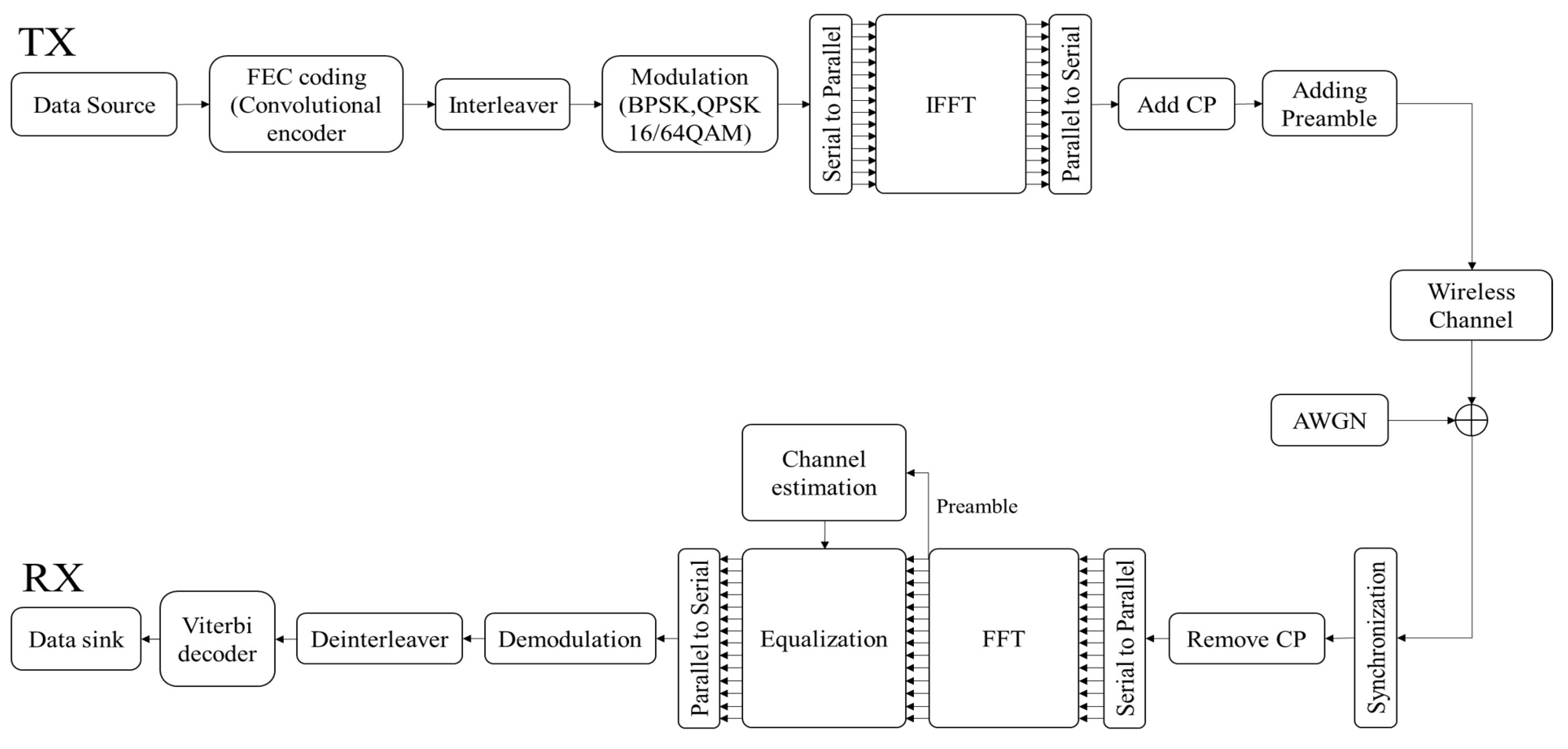
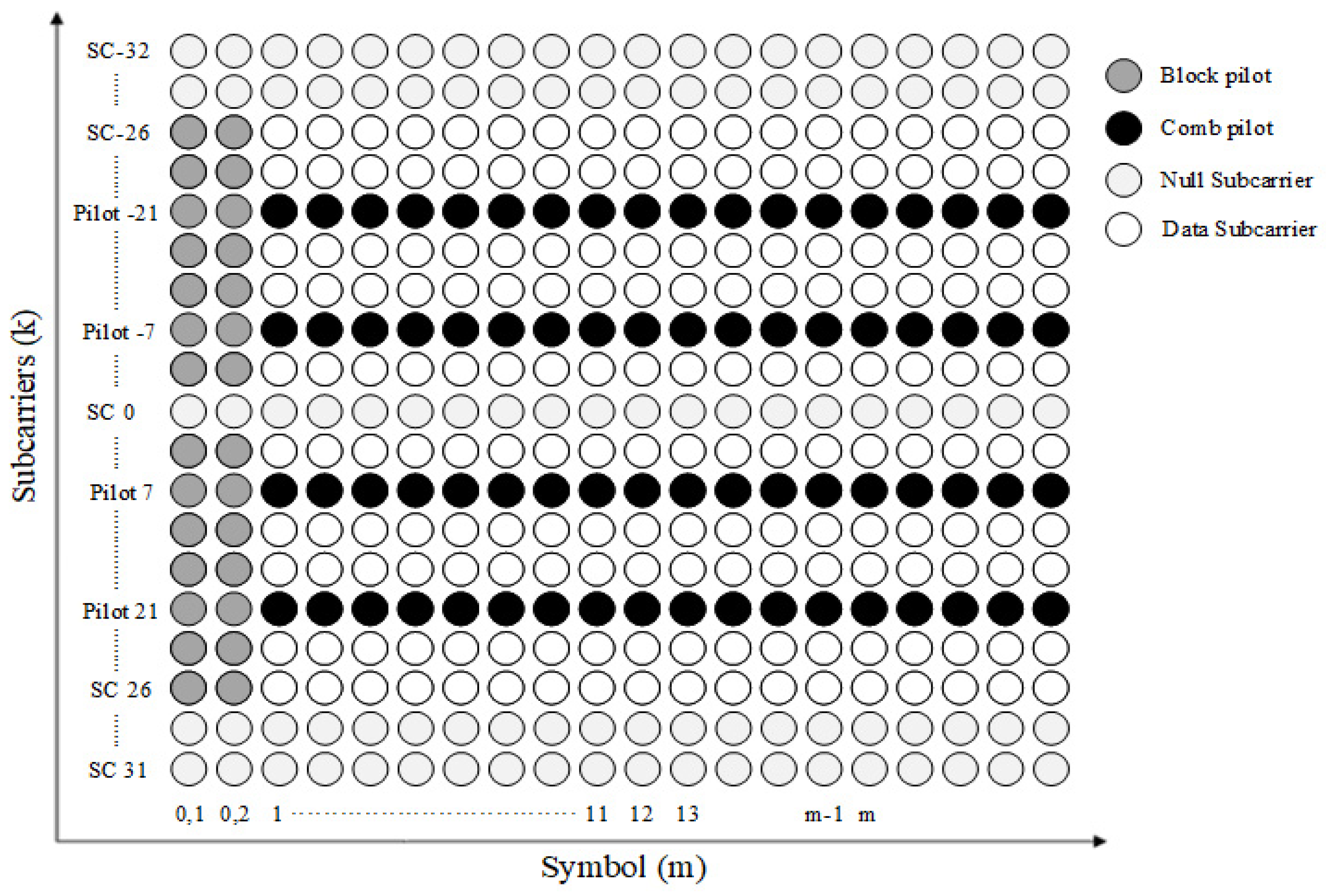
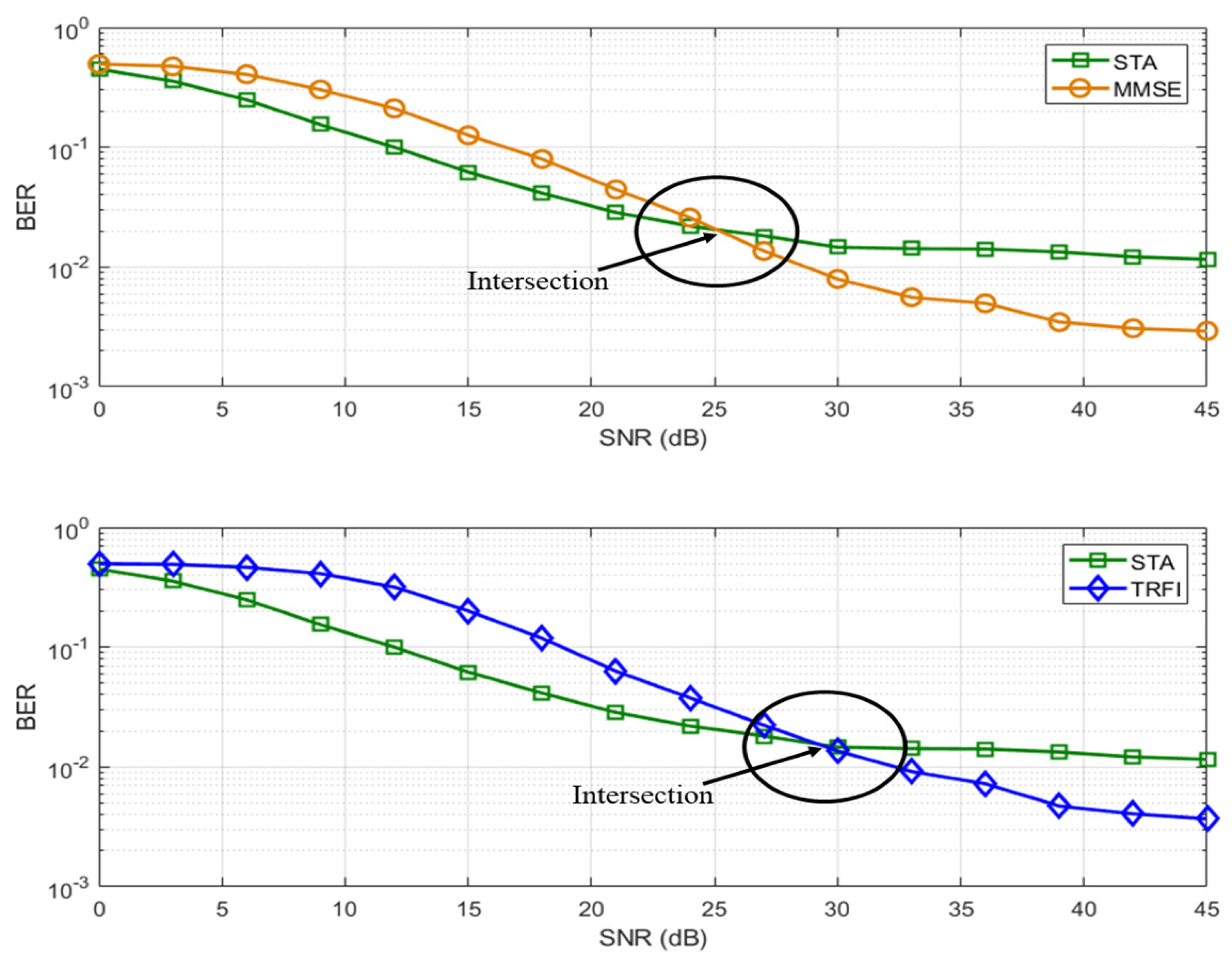
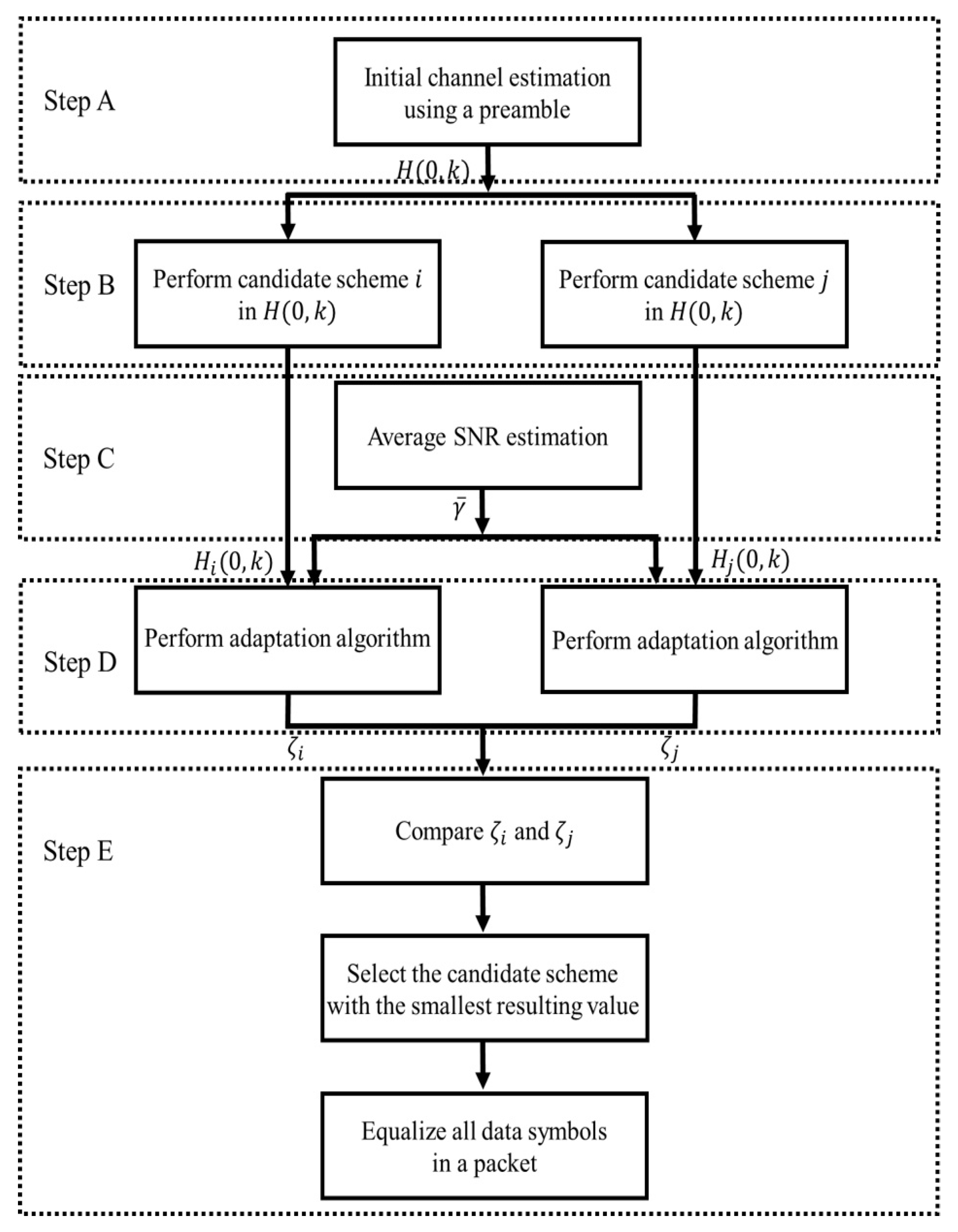
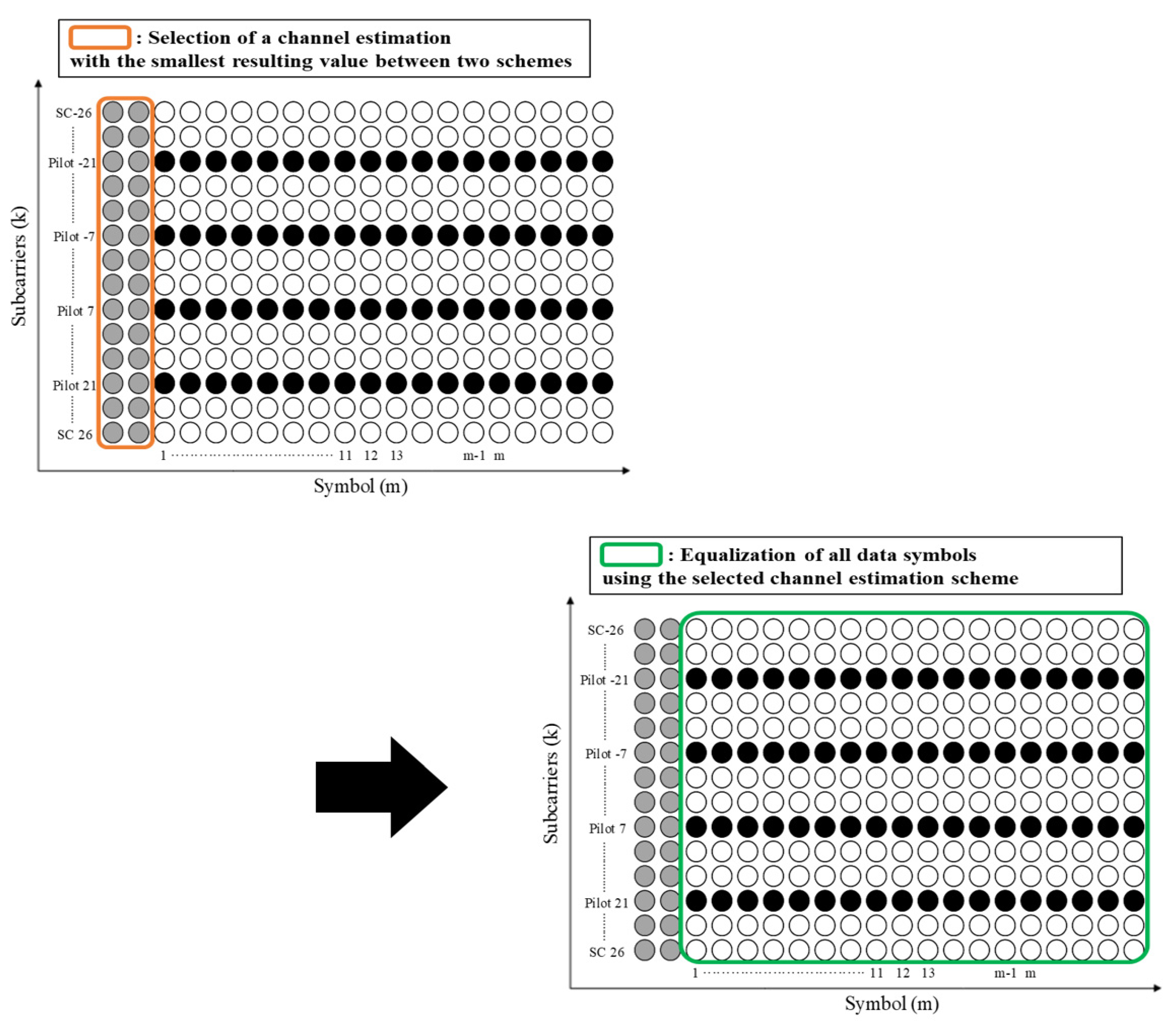
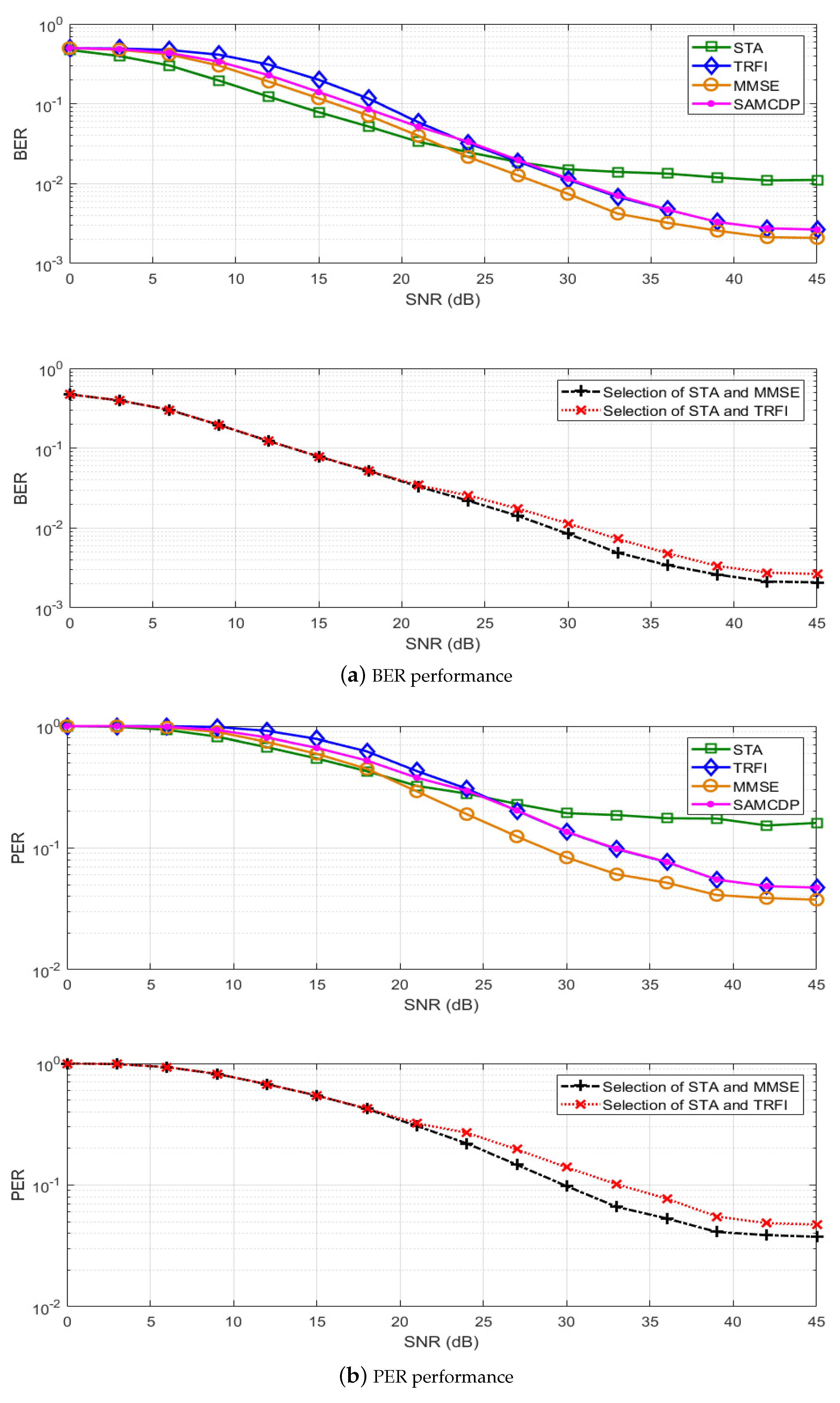
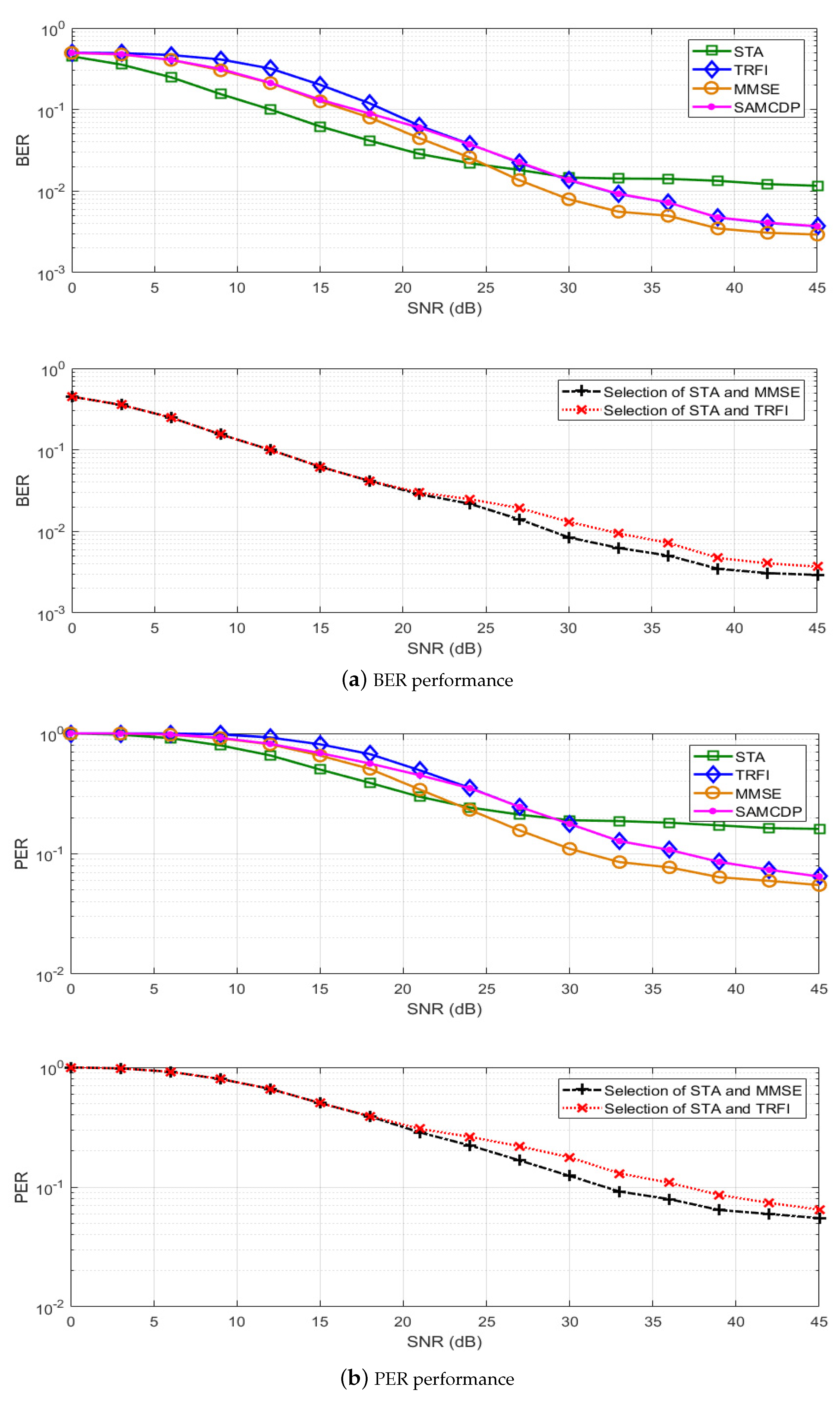
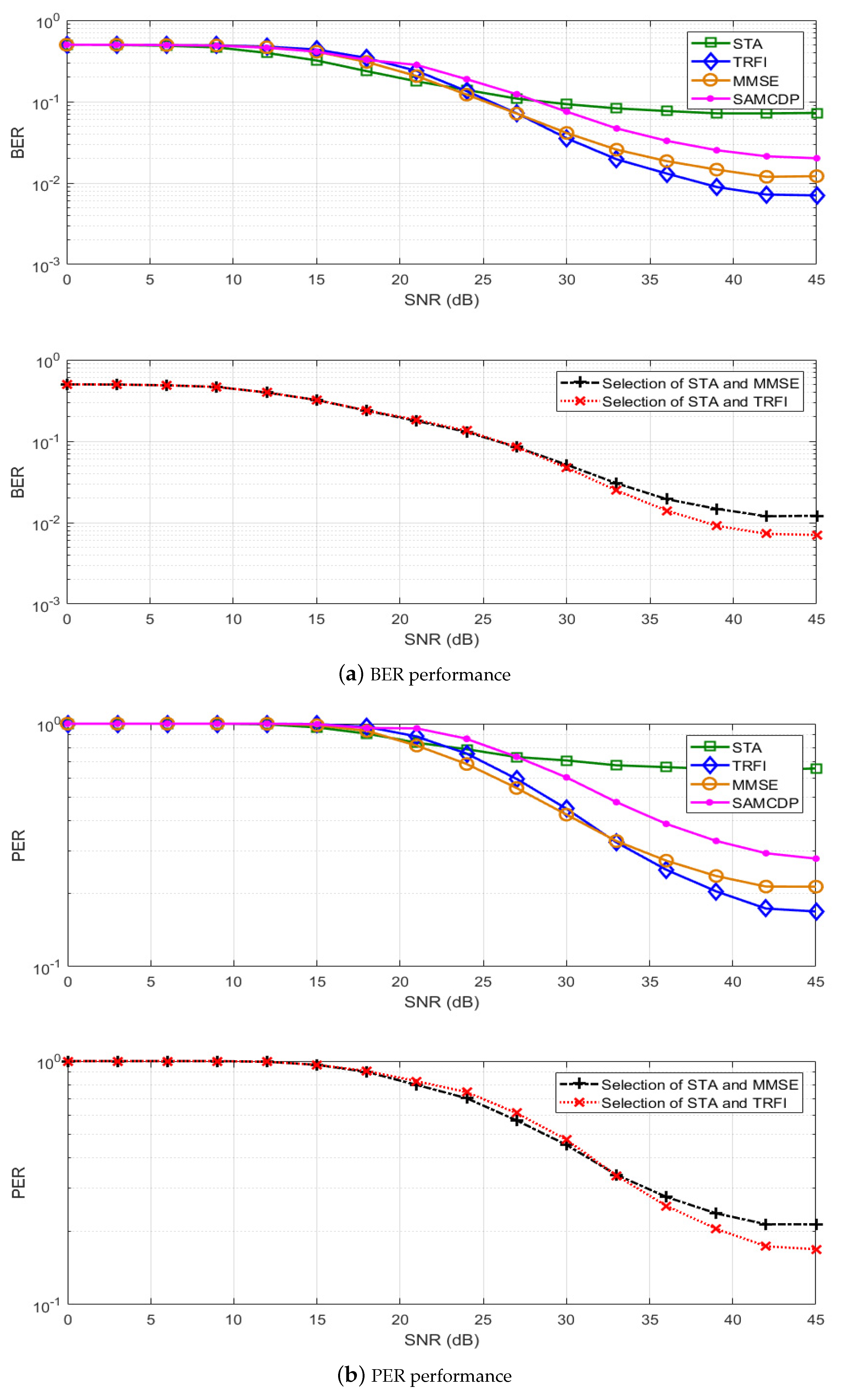
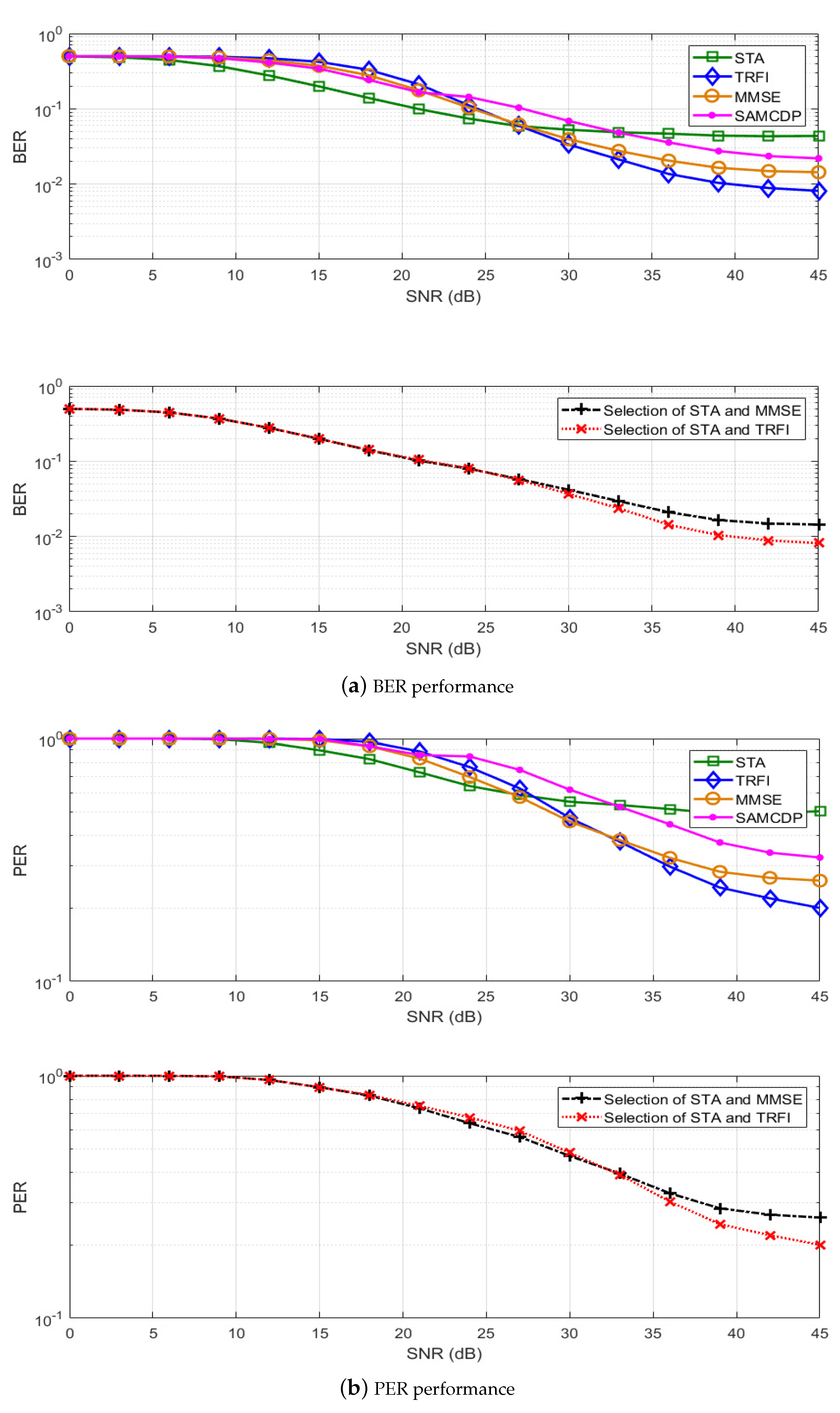
| Parameter | Value |
|---|---|
| Bandwidth | 10 MHz |
| Bit rate | 3, 4.5, 6, 9, 12, 18, 24, 27 Mbps |
| Modulation schemes | BPSK, QPSK, 16QAM, 64QAM |
| Code rate | 1/2, 2/3, 3/4 |
| Data subcarriers | 48 |
| Pilot subcarriers | 4 |
| Total subcarriers | 64 |
| FFT period | 6.4 s |
| CP duration | 1.6 s |
| Symbol duration | 8.0 s |
| Subcarrier spacing | 0.15625 MHz |
| Scenario | Distance between TX & RX (m) | Velocity (km/h) | Doppler Shift (Hz) | Maximum Excess Delay (s) |
|---|---|---|---|---|
| V2V Expressway Oncoming | 300–400 | 104 | 1000–1200 | 0.3 |
| V2I Urban Canyon | 100 | 32–48 | 300 | 0.5 |
© 2019 by the authors. Licensee MDPI, Basel, Switzerland. This article is an open access article distributed under the terms and conditions of the Creative Commons Attribution (CC BY) license (http://creativecommons.org/licenses/by/4.0/).
Share and Cite
Choi, J.-Y.; Jo, H.-S.; Mun, C.; Yook, J.-G. Preamble-Based Adaptive Channel Estimation for IEEE 802.11p. Sensors 2019, 19, 2971. https://doi.org/10.3390/s19132971
Choi J-Y, Jo H-S, Mun C, Yook J-G. Preamble-Based Adaptive Channel Estimation for IEEE 802.11p. Sensors. 2019; 19(13):2971. https://doi.org/10.3390/s19132971
Chicago/Turabian StyleChoi, Joo-Young, Han-Shin Jo, Cheol Mun, and Jong-Gwan Yook. 2019. "Preamble-Based Adaptive Channel Estimation for IEEE 802.11p" Sensors 19, no. 13: 2971. https://doi.org/10.3390/s19132971
APA StyleChoi, J.-Y., Jo, H.-S., Mun, C., & Yook, J.-G. (2019). Preamble-Based Adaptive Channel Estimation for IEEE 802.11p. Sensors, 19(13), 2971. https://doi.org/10.3390/s19132971






